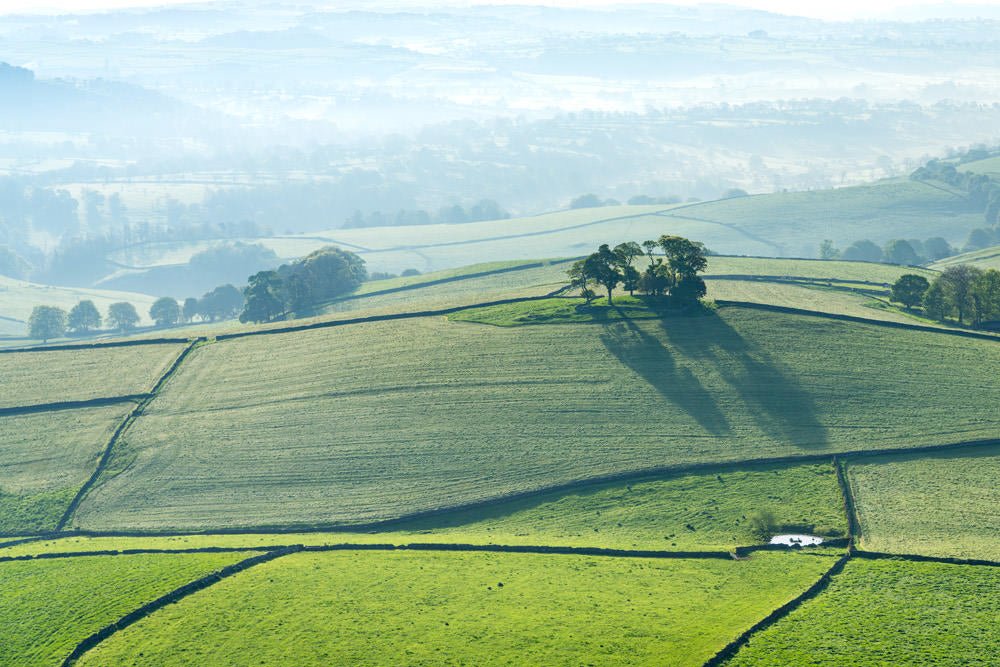Nestled in the heart of England, the Peak District National Park is a revered landscape covering parts of Derbyshire, Cheshire, Staffordshire, Yorkshire, and Greater Manchester. This area of natural beauty spans 555 square miles (1,438 square kilometres), attracting millions who visit for its breathtaking scenery and diverse wildlife.
What makes this park truly remarkable is its historical significance as the first national park in the United Kingdom, designated on 17th April 1951. From rolling hills and deep valleys to picturesque villages and expansive moorland, the Peak District leverages its rich cultural and geological heritage to offer a unique experience for adventurers and nature enthusiasts alike.
1. The Peak District became the UK's first national park in 1951.
The Peak District holds the distinction of being the UK's inaugural national park. Officially designated on 17 April 1951, it was the first of 15 national parks established in the UK.
This milestone marked a significant development in the movement to protect natural areas for public enjoyment and conservation.
The creation of the Peak District National Park followed decades of campaigning and public advocacy. One notable event that contributed to this cause was the Kinder Mass Trespass in 1932. This protest highlighted the lack of public access to the countryside and built momentum for legislative change.
James Bryce, an MP in the 1880s, was also instrumental in this movement. He initiated the first freedom to roam bill, advocating for public access to rural areas. Though his initial efforts were unsuccessful, they laid the groundwork for future successes.
Located in the heart of England, the Peak District covers an extensive area of 555 square miles (1,438 square kilometres), roughly the size of Greater London. Its designation as a national park ensures that it remains a protected landscape.
The park's establishment has had a profound impact on fostering outdoor recreation. It attracts ramblers, climbers, cyclists, and photographers who are drawn to its diverse terrain and natural beauty.
Being the first national park set a precedent for future designations across the UK, contributing to the nationwide network of protected areas that exists today. This historic achievement underscores the importance of preserving natural landscapes for future generations.
2. The park covers 555 square miles across five counties
The Peak District National Park covers an area of 555 square miles. This vast expanse is located in the heart of England and encompasses parts of Derbyshire, Cheshire, Staffordshire, Yorkshire, and Greater Manchester.
Derbyshire holds the largest portion of the park. Its diverse landscapes and picturesque villages provide the quintessential Peak District experience.
Cheshire contributes to the western edges of the park. This county is known for its rolling hills and pastoral scenery.
Staffordshire stretches into the southern parts of the Peak District. It offers rugged moorlands and historic towns that tell tales of England's past.
Yorkshire brings a unique charm to the northeastern boundaries of the park. This region includes the dramatic landscapes of the Dark Peak area.
Greater Manchester offers an urban contrast. The northerly fringe of the park touches this bustling metropolitan area, showcasing the balance between natural beauty and city life.
Together, these five counties create a richly varied environment. Here, visitors can explore a wealth of natural and cultural attractions within a single national park.
3. It has over 1,600 miles of footpaths for walking enthusiasts.
Peak District National Park boasts more than 1,600 miles of footpaths, bridleways, and tracks. This makes it a paradise for walking enthusiasts. The extensive network of trails caters to all levels of walkers, from casual strollers to seasoned hikers.
These paths traverse varied landscapes, including moorlands, valleys, and woodlands. Walkers can explore both the White Peak and the Dark Peak areas. Each offers unique scenery and challenges.
The Peak District Boundary Walk is one such trail. It circumnavigates the entire park, offering a comprehensive way to experience the area. For those looking for a shorter journey, the walk can be enjoyed in stages.
Kinder Scout, the highest point in the Peak District, is a popular destination. It provides stunning views and a rewarding hike. The park also has numerous well-maintained paths following old rail routes. These include the popular Monsal Trail and High Peak Trail.
Access land is another feature of the park. There are 202 square miles of it, allowing walkers to roam freely without sticking to paths. This gives a sense of adventure and the freedom to explore lesser-known spots.
The variety of trails ensures that there is something for everyone. Whether it’s a gentle walk along a river, a challenging hike up a peak, or a multi-day trek, the Peak District caters to all preferences.
With such a vast network of trails, the Peak District remains a top destination for walking enthusiasts.
4. The Peak District attracts around 13 million visitors annually.
Each year, the Peak District National Park sees approximately 13 million visitors. This makes it one of the most visited national parks in the United Kingdom.
The region's diverse landscapes draw outdoor enthusiasts, nature lovers, and tourists from around the world.
Attractions such as hiking trails, picturesque villages, and cultural heritage sites contribute to its popularity. The park's central location, spanning parts of Derbyshire, Cheshire, Staffordshire, Yorkshire, and Greater Manchester, enhances its accessibility.
Events and activities throughout the year add to the influx of visitors. Seasonal festivals, local markets, and guided tours offer engaging experiences for everyone.
5. Mam Tor is known as the 'Shivering Mountain' due to frequent landslides
Mam Tor is a notable hill located near Castleton in the High Peak of Derbyshire, England. Standing at 517 metres (1,696 feet), it holds a unique position within the Peak District National Park.
The hill's alternative name, 'Shivering Mountain', originates from the frequent landslips that occur on its eastern face. These landslides are largely due to the presence of unstable shale rock layers.
These landslips have shaped the landscape around Mam Tor, resulting in numerous smaller hills or 'mini-hills' forming beneath the main summit. This geological activity contributes to the distinctive appearance of the area.
Mam Tor's landslides have had a significant impact on human infrastructure as well. A prominent road that once crossed below the hill was abandoned in 1977 due to the ongoing instability and cost of repairs.
Visitors to Mam Tor often find the combination of natural beauty and geological intrigue to be a compelling reason to explore the area. The hill offers stunning views of the surrounding Hope Valley, making it a popular destination for walkers and nature enthusiasts.
6. Chatsworth House, located in the Peak District, was used in the film 'Pride and Prejudice'
Chatsworth House is a grand stately home situated in the Derbyshire Dales of the Peak District National Park. Owned by the Cavendish family since 1549, it is the seat of the Duke of Devonshire.
This historic mansion has been featured in numerous films and television series due to its stunning architecture and picturesque grounds. Most notably, it served as the setting for the fictional Pemberley in the 2005 adaptation of 'Pride and Prejudice', starring Keira Knightley.
Both the exteriors and interiors of Chatsworth House were prominently used in the film. This gave audiences a glimpse of its lavish rooms and beautifully maintained gardens. Chatsworth’s grandeur brought the character of Mr. Darcy’s estate to life, enhancing the film's period setting.
Visitors can still tour the house and grounds, experiencing scenes from 'Pride and Prejudice' first-hand. Tours often highlight these cinematic moments, drawing fans of the film from all over the world.
Located near Bakewell, the house is easily accessible by car and public transport. With its historical significance and cinematic connections, Chatsworth House remains a popular destination in the Peak District.
7. Kinder Scout is the highest point in the Peak District at 636 metres
Kinder Scout reaches an elevation of 636 metres (2,087 feet), making it the highest point in the Peak District. This moorland plateau is located in the Dark Peak area of Derbyshire, England.
The landscape of Kinder Scout is diverse and includes rugged terrain, deep cloughs, and expansive peat bogs.
The plateau is also a National Nature Reserve, highlighting its environmental significance. Walking routes to the summit are popular among hikers and provide sweeping views of the surrounding countryside.
One notable historical event associated with Kinder Scout is the 1932 Mass Trespass. This act of civil disobedience played a crucial role in securing public access to the countryside. The event is commemorated by plaques and continues to be celebrated by walkers and nature enthusiasts.
There are multiple paths to reach the summit, including routes via Jacob's Ladder and Fairbrook. Each route offers unique scenery and challenges for hikers of varying skill levels.
The geological and ecological features of Kinder Scout offer valuable insights into natural processes and environmental conservation.
Visitors to Kinder Scout can experience a range of weather conditions due to its elevation, so proper preparation is essential.
8. The park is home to a diverse range of wildlife, including red deer and peregrine falcons.
The Peak District National Park is renowned for its remarkable biodiversity. Its varied habitats support an array of wildlife, making it a haven for nature enthusiasts.
Red deer, the largest terrestrial mammal in the UK, roam the moorlands and woodlands of the park. They are often seen grazing in small herds, contributing to the park's picturesque landscapes.
Peregrine falcons are another notable species within the park. These birds of prey are recognised for their incredible speed, reaching over 200 mph during their hunting stoop. Visitors to the park might catch a glimpse of these majestic birds soaring or perched on cliffs.
Other wildlife in the park includes mountain hares, which can be spotted in the higher, cooler areas. These hares turn white in winter, blending into the snowy landscape.
The water vole, a species facing decline in many parts of the UK, finds refuge in the park’s waterways. Conservation efforts are ongoing to protect their habitats.
Birdwatchers can enjoy sightings of the red grouse, known for its distinctive reddish-brown plumage, amidst the heather-clad moors.
The Peak District also supports various bat species, including the rare Nathusius’ pipistrelle. These nocturnal mammals can often be seen flitting in the twilight skies.
Amphibians like the great crested newt are another important part of the park's ecosystem. These newts frequent the area’s ponds and wetlands.
The diversity of wildlife in the Peak District underscores the importance of habitat protection and conservation efforts, ensuring these species can thrive for generations to come.
9. The Pennine Way, a famous long-distance trail, begins in Edale in the Peak District.
The Pennine Way is a celebrated long-distance walking route in the UK. Starting in Edale, a picturesque village in the Derbyshire Peak District, this trail covers 268 miles (431 km) and stretches to Kirk Yetholm in the Scottish Borders.
As the first National Trail in England, the Pennine Way was inaugurated on 24 April 1965. This pioneering path offers walkers access to some of England's most rugged and beautiful landscapes.
The route traverses diverse terrains, including the Peak District, the Yorkshire Dales, and the North Pennines. Each section promises unique experiences and stunning views.
Walkers on the Pennine Way encounter a mix of steep ascents and descents, navigating a variety of gates, stiles, and bridges. The trail is well-marked, making it accessible to seasoned hikers and adventurous newcomers alike.
Edale is well-known among hiking enthusiasts as the gateway to this legendary trail. Its starting point at the Old Nag's Head public house marks the beginning of an extraordinary journey through some of Britain's most scenic uplands.
The Pennine Way's reputation for being challenging is well-earned, with a combined ascent exceeding the height of Mount Everest. Despite the difficulties, it remains a favourite among those who seek to explore England's natural beauty.
Walkers enjoy not only the physical challenge but also the historic paths and breathtaking landscapes that define the Pennine Way. The trail's contribution to public access and appreciation of these wild areas continues to be significant.
10. Blue John Cavern is renowned for its rare Blue John stone
Blue John Cavern is located in Castleton within the Peak District National Park. It is famous for its unique deposits of Blue John stone, a rare, colour-banded form of fluorspar.
The cavern is one of the only places in the world where Blue John stone is found, making it a significant site for both geologists and jewellery enthusiasts.
Visitors to Blue John Cavern can explore the stunning cave formations that house these precious stones. The site offers guided tours where knowledgeable staff share the history and geology of Blue John stone.
In addition to the visual splendour of the cave itself, there are interactive experiences available. Guests can participate in crafting workshops to create their own jewellery from Blue John stone, under the guidance of skilled craftspeople.
Blue John Cavern also includes a well-stocked gift shop offering various items crafted from the stone. These range from simple ornaments to intricately designed jewellery pieces.
The cavern's history adds another layer of fascination. Blue John stone has been prized for hundreds of years, and its limited availability contributes to its allure. Only two mines, Treak Cliff Cavern and Blue John Cavern, continue to produce this mineral today.
Exploring Blue John Cavern is not just a visit to a mine; it's a journey through one of the Peak District's most cherished natural treasures.
Geography and Location
The Peak District National Park lies predominantly in Derbyshire, spanning several counties and offering a mix of geological formations and scenic landscapes.
Area Coverage
The Peak District National Park covers an expansive area of 555 square miles (1,438 square kilometers). This national park reaches into multiple counties, including Derbyshire, Cheshire, Staffordshire, Yorkshire, and Greater Manchester.
The park’s broad expanse makes it roughly the size of Greater London, highlighting its significant geographical footprint. Established as the UK’s first national park in 1951, the Peak District's central location provides easy accessibility from major urban areas, contributing to its popularity among visitors.
Landscape Features
The Peak District's landscape is characterised by a unique blend of natural beauty, shaped over thousands of years. The region includes the Dark Peak and White Peak areas.
The Dark Peak, primarily composed of gritstone, features rugged moorlands such as Kinder Scout, which is the highest point at 2,088 feet (636 meters) above sea level. In contrast, the White Peak lies on limestone and is renowned for its rolling pastures and deep dales. These diverse geological features create varied habitats, supporting a wide range of flora and fauna.
Flora and Fauna
The Peak District National Park's diverse landscapes create unique habitats supporting a wide range of plant species and wildlife. This combination makes it an ideal destination for nature enthusiasts and researchers alike.
Plant Species
The Peak District showcases a rich variety of plant species, reflecting its distinct geographical areas. The White Peak region is renowned for its limestone dales, which host flower-rich meadows, including rare orchids, cowslips, and wild thyme.
In contrast, the Dark Peak region, characterised by gritstone edges and moorlands, features peat bogs rich in heather and cotton grass.
The South West Peak has a combination of rolling hills and intimate habitats, supporting a mix of grasslands, woodlands, and wetlands. Notably, the upland mixed ashwood in the White Peak is of international importance due to its diverse flora.
Wildlife Diversity
The park supports a wide array of wildlife, benefiting from its varied habitats. The White Peak is home to numerous butterfly species and birds such as skylarks and curlews.
In the Dark Peak, birdlife thrives with species like red grouse, golden plovers, and merlins. The region’s bogs support unique amphibians and invertebrates.
The South West Peak features mammals like otters and water voles in its rivers and streams. Additionally, this area supports a mosaic of habitats crucial for various bird and insect species. The park's careful management ensures the survival and proliferation of these species, maintaining its reputation as a biodiverse haven.
Latest Product Reviews
A Proud Kase UK Partner
The use of high quality glass filters for landscape photography is quite simply game changing and will improve your resulting images. I am happy to talk filters and help you get started, start a conversation here









